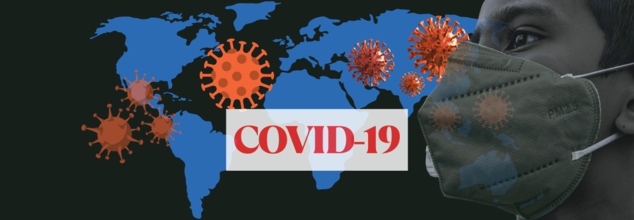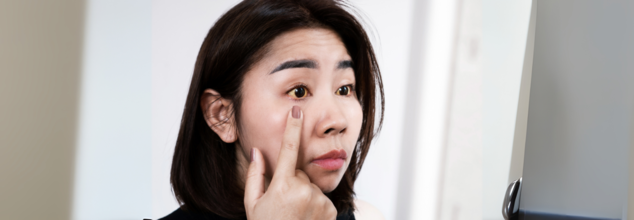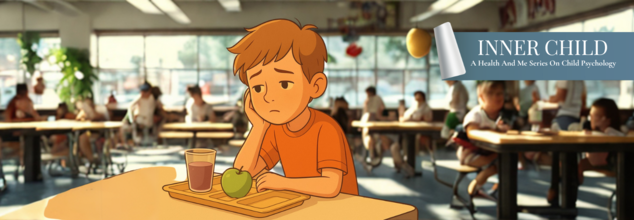- Health Conditions A-Z
- Health & Wellness
- Nutrition
- Fitness
- Health News
- Ayurveda
- Videos
- Medicine A-Z
- Parenting
- Web Stories
COVID-19 Returns? Is The New Variant Worse And How Long Will You Be Sick With It?

With the world continuing to inch away from the height of the COVID-19 pandemic, a fresh wave of infections is again causing concern—this time fueled by new subvariants of the Omicron variant. Southeast Asia, more so urban areas in Singapore, Hong Kong, and sections of India, is experiencing a rise in COVID-19 infections propelled by the JN.1 variant and its sub-lineages LF.7 and NB.1.8 but is it a new pandemic in the making?
How severe is the new variant? And what should you do if you become infected? All three of these countries have officially reported an increased surge in infections. In India, while numbers are still low by comparison, Kerala is the leader in new cases (69 as of mid-May), followed by Maharashtra, Tamil Nadu, Karnataka, and Delhi. Experts explain the acceleration of cases not due to increased virulence but due to behaviors such as erosion of immunity and fatigue around prevention strategies.
Most recent data from Southeast Asian health ministries reveal a sudden surge in cases of Covid-19 in Hong Kong, Singapore, China, and Thailand. In Singapore, the Ministry of Health's rare update—its first since nearly a year ago—recorded a 28% jump in weekly cases to 14,200 for the week to May 3. The daily hospital admissions have also increased about 30%.
Meanwhile, Hong Kong is also experiencing a sharp peak. The Centre for Health Protection indicated the positivity rate of respiratory samples rose from 1.7% mid-March to 11.4%, greater than the August 2024 peak. There have been 30 fatalities in 81 severe adult cases in the past month, the majority involving individuals over 65 and with existing medical conditions.
The trend is concerning and part of a wider pattern sweeping across the region. Thailand experienced fresh clusters of infections following its heavily publicized Songkran holiday in April, and mainland China's test positivity rates have risen by over double since late March, approaching that of its summer 2024 wave.
The new wave of COVID has brought the JN.1 variant of Omicron into the spotlight, which is responsible for the latest surge in numbers. In India alone, there are 257 active cases, and the discussion about safety, new policies and health issues has started.
The present surge in COVID-19 cases is being majorly spurred by new Omicron subvariants, most notably JN.1. That variant and its offspring LF.7 and NB.1.8, are being found highly contagious. "These variants are too easy to spread and disrupt the body's immunity and cause another infection," says Dr. Harish Bhatia, Senior Chest Specialist & Director & Head Dept. Of Respiratory Medicine
The World Health Organization (WHO) has classified JN.1 as a "variant of interest," subsequently promoting it to a "variant of concern." Nevertheless, world health authorities continue to assert that the public health risk is low at this point.
Is JN.1 More Dangerous Than Previous Variants?
The JN.1 strain, though better at spreading, has not indicated signs of making healthy people sicker. "The good part," Dr. Bhatia explains, "is that this variant seems to produce milder disease in healthy individuals."
But there is an exception. The old, the immunocompromised, or those with pre-existing conditions such as diabetes or heart disease are still at increased risk of developing complications. For them, even a "mild" strain could be a potentially deadly affair. It's a warning that COVID-19 is not yet "just another cold."
Symptoms Of Covid-19 JN.1 Variant To Watch For
The symptoms of JN.1 and its sub-lineages are very similar to those of previous Omicron variants, affecting the upper respiratory system. Typical symptoms are:
- High temperature
- Runny nose
- Sore throat
- Headaches
- Body aches
- Exhaustion or tiredness
- Mild gastrointestinal distress (in some individuals)
The majority of individuals recover with rest at home, but the duration and intensity depend on one's immune response and health condition.
Covid-19 JN.1: How Long Will You Be Sick?
Experts say that the average recovery period for a light COVID-19 disease caused by the JN.1 variant is 5 to 7 days. Yet, some of the symptoms—especially fatigue and cough—can persist for 2 to 3 weeks.
Dr. Bhatia suggests that in case of persistence of the symptoms beyond 10 days or deterioration—particularly high-grade fever or respiratory difficulty—medical help must not be delayed. "It is important to listen to your body and not overlook warning signs," he adds.
Covid-19 JN.1: What to Do If You Get Infected?
In case you test positive for COVID-19, here is what public health officials suggest:
Isolate for a minimum of 5 days, or until your symptoms resolve. For extra caution, isolate up to 10 days.
- Drink plenty of fluids and get plenty of rest. Symptomatic treatment with paracetamol for fever and muscle pain is often adequate.
- Keep track of your symptoms, particularly if you fall into a high-risk group.
- Get professional assistance if you have difficulty breathing, chest discomfort, or unrelenting high fever.
- Notify close contacts to watch for symptoms and test as necessary.
- Prevent contact with high-risk individuals for a minimum of 10 days.
Although hospitalization is not necessary for healthy persons in most cases, early diagnosis and treatment are important to avoid complications.
Covid-19 JN.1: How to Stay Safe?
Though the world has transitioned away from the period of global emergency of the pandemic, the virus keeps mutating. Remaining guarded is still important—particularly during surges such as this one.
Dr. Bhatia points out, "Wearing a mask in public places, regularly washing your hands, keeping your vaccinations current—including booster shots—and keeping your distance from someone who is infected are still effective measures."
Besides, the immunocompromised individuals or those with vulnerable family members should take extra precautions and advise their healthcare professionals about preventive drugs or vaccines beyond the primary doses.
COVID-19 is frequently no longer making headlines as it did in 2020, but its presence is certainly not done yet. The advent of JN.1 and other subvariants is a grim reminder that the virus continues to mutate—and so must our strategy against it.
Dr. Harish Bhatia is Senior Chest Specialist & Director & Head Dept. Of Respiratory Medicine with MGS Hospital and the Founder Director of Rebreathe Clinic.
Silent Sign Of High Cholesterol Can Show Up In Your Eyes - Here's How You Can Identify It

(Credit-Canva)
Our lifestyle habits play an important role in how well we live. While some health concerns are more visible, silent killers like high cholesterol should always be kept an eye on because it can have serious health issues.
Keeping an eye on your cholesterol levels is really important for your health. Too much of this fatty substance in your body can be dangerous because it might block blood vessels, potentially leading to a life-threatening stroke or heart attack. Interestingly, your eyes might give you a clue if your cholesterol is too high.
Yellow Bumps Around Your Eyes
The American Association of Ophthalmology points out that if you start to see "yellow bumps around the eyes," this could be a sign of dangerously high cholesterol. These bumps are known as xanthelasma, and if you notice them, you should see a doctor right away.
That's because xanthelasma can sometimes be an early warning sign of three very serious eye conditions: age-related macular degeneration, retinal vein occlusion, and corneal arcus. The good news is a simple blood test can check your cholesterol levels, and your doctor or nurse can discuss the results with you.
Understanding Your Cholesterol Numbers
When you get your cholesterol tested, the results usually include:
- Total cholesterol: This is the overall amount of cholesterol.
- HDL (high-density lipoprotein) cholesterol: Often called "good" cholesterol.
- Non-HDL cholesterol: This is the "bad" cholesterol, and it's a key number to watch.
For a healthy person, a healthy total cholesterol reading should be below 5mmol/L. Your HDL (the good kind) should be above 1mmol/L. Most importantly, your non-HDL reading should ideally be below 4mmol/L. Your doctor might also give you a QRISK score, which estimates your risk of developing a heart or circulation problem over the next 10 years.
How Does High Cholesterol Affect Your Health?
According to the Centers of Disease Control and Prevention having too much cholesterol in your blood can cause a sticky substance called "plaque" to build up on the inside walls of your arteries. Arteries are like pipes that carry blood from your heart to the rest of your body.
Over time, as more plaque builds up, these arteries get narrower. This narrowing makes it harder for blood to flow freely to and from your heart and other important organs. When blood flow to the heart is blocked, it can cause chest pain (also called angina) or even a heart attack.
This cholesterol buildup in your arteries can also greatly increase your risk for heart disease and stroke, which are serious health problems.
What Puts You At Risk of High Cholesterol?
Some health problems, like type 2 diabetes and obesity, can raise your risk for high cholesterol. Your daily habits also play a big part. Eating foods high in unhealthy fats (called saturated and trans fats) and not moving your body enough can also increase your risk. For some people, high cholesterol runs in their family, meaning they're more likely to get it too. All these things that increase your chances are called "risk factors."
You can't change some risk factors, like your age or your family history. But you can take steps to lower your risk by changing the things you can control, like your diet and how active you are.
Simple Ways to Lower Cholesterol
The good news is that making small changes to your diet can significantly improve your cholesterol levels.
For example, instead of choosing items like meat pies or sausages, try to eat oily fish such as mackerel and salmon. You can still enjoy familiar meals; for instance, swap a meat pie for salmon served with mashed potatoes and peas. Also, opt for brown rice instead of white rice, whole grain bread instead of white bread, and wholewheat pasta.
When you're looking for snacks, choose healthier options like nuts, seeds, and fruit instead of cakes and biscuits.
Beyond diet, it's also crucial to move your body for at least 20 minutes every day. This could be a brisk walk, swimming, cycling, or playing a sport. The key is to find activities you enjoy, as you're much more likely to stick with them if you do!
Inner Child: Being Left Out And Rejected In Childhood Becomes A Social Seed For Deeper Connections

Credits: Health and me
Imagine a fourth-grader in a classroom full of chatter and potential. The teacher announces, “Form your groups,” and he waits—scanning faces, hoping someone gestures toward him but no one does. That ache in the chest? That’s not just embarrassment or disappointment it’s rejection—and for kids, it lands with surprising force. Or consider the reality for a teenager who finds out that their friends hosted a dinner party sans their invitation. These experiences are not just momentary disappointments; they can be deeply ingrained in the fabric of our emotions, influencing not just behaviors but our mental well-being.
We often think of rejection as a bruising experience to be avoided. As adults, we know the sting—being passed over for a promotion, left out of a gathering, or ghosted after a second date. But for children navigating their earliest friendships and social landscapes, rejection can feel like a signal flare going off in their brains. And according to new and emerging research, that pain might actually be useful.
Rejection, as it turns out, is more than just a blow to the ego. It’s a biological signal, a teaching moment, and a map to social understanding—especially during childhood. Far from just scarring kids, it can guide them to build stronger, more meaningful relationships, if we understand what’s happening beneath the surface.
Rejection as a Social Learning Tool
Social psychology and neuroscience researchers have spent years untangling the emotional toll of rejection and here’s what they’ve found: rejection doesn’t just feel bad—it actually activates the same areas of the brain involved in physical pain. The anterior cingulate cortex, to be specific.
From an evolutionary standpoint, rejection has profound significance. Our ancestors likely cultivated social bonds for survival. In prehistoric times, being excluded from social groups jeopardized one's safety and resource access, rendering social belonging a fundamental human necessity. Hence, our brains evolved to respond with urgency to feelings of rejection; the anterior cingulate cortex—known to activate in response to physical pain—fires up in reaction to social exclusion.
There’s more to it than hurt feelings, as social psychologists puts it, rejection is not just pain—it’s feedback. Neuroscience has revealed intriguing insights into this complex interplay of feelings and actions. In an environment where social dynamics are not static but constantly evolving, children learn to read behaviors, decipher intentions, and refine their assumptions throughout their experiences with peers. Early rejection may lead to reflection on one's behavior, intentions, and ultimately, a more keen ability to navigate future interactions.
In studies where participants were excluded from a simple virtual ball-tossing game, their brains didn’t just light up from distress—they showed signs of processing surprise. That surprise, researchers now believe, may be what turns rejection into a learning signal.
What this means is that the brain doesn’t just say, “Ouch, that hurt.” It says, “Wait, what happened—and what can I do differently next time?” In the social landscape, especially among kids, rejection may actually help refine how they approach relationships in the future. It becomes a kind of emotional GPS—updating their internal models of trust, value, and connection.
How the Brain Processes Acceptance and Rejection Differently?
Intriguingly, while an anxious child might avoid disruptive behaviors, a child conditioned to anticipate rejection might instead develop a more rebellious stance against peer conformity. This indicates that rejection can lead to various coping mechanisms, thereby influencing children’s decision-making processes when navigating peer relationships.
Recent research has found that the brain treats social rejection and acceptance as distinct—but complementary—forms of learning.
When someone experiences acceptance, areas like the ventral striatum activate. That’s the part of the brain associated with rewards like praise, money, or affection. In contrast, the anterior cingulate cortex processes social devaluation or rejection—but not just as emotional pain. It recalibrates a person’s sense of social standing, helping them update beliefs about where they stand in the group.
So when kids are rejected, especially unexpectedly, their brains are doing more than just hurting. They’re recalculating relational value: Who likes me? Who doesn’t? Who can I trust?
That recalibration can actually lead to better social decision-making. It helps kids discern between relationships worth investing in and those that may not be safe or reciprocal. That’s a skill they’ll need their entire lives.
While rejection can serve as a powerful teacher, it’s not experienced the same way by every child. New research from the University of Georgia reveals two key reactions in children who are sensitive to rejection:
Rejection Expectancy: A cognitive pattern where children assume they’ll be rejected.
Anxious Rejection Anticipation: An emotional state where the child fears being excluded, even without evidence.
These patterns show up in fascinating—and sometimes contradictory—ways.
Children who fear rejection tend to conform more. They try harder in school, follow rules more closely, and avoid troublemaking behaviors. In essence, they try to stay in good standing by blending in and performing well.
On the other hand, children who expect rejection often resist conforming. They’re less likely to follow group norms or academic expectations, perhaps because they’ve already assumed there’s no reward in fitting in.
This split in behavior shows that rejection isn’t just a one-size-fits-all experience. How a child interprets rejection—cognitively and emotionally—shapes whether it motivates connection or fuels isolation.
When Rejection Teaches the Wrong Lessons?
Of course, not all rejection leads to growth. Chronic or repeated social exclusion—especially in environments marked by bullying or relational aggression—can reinforce a child’s belief that they are unworthy of connection. This can lead to emotional withdrawal, aggression, or symptoms of depression, often before those children even have the language to articulate their pain.
Children who don’t receive support after rejection may also misread future social cues, seeing threats where none exist. In extreme cases, this hypersensitivity can contribute to the development of conditions like borderline personality disorder, which is often characterized by unstable relationships and intense emotional responses to both praise and criticism.
That’s why parental and educator intervention is crucial. Teaching children to understand and regulate their emotional responses to rejection—and to make sense of their social world—is just as important as teaching math or reading.
What Can Adults Do to Help?
When kids experience rejection, adults often respond with platitudes: “They’re just jealous,” or “You don’t need them anyway.” But these responses, though well-meaning, can invalidate a child’s feelings or prevent them from developing the skills to handle future rejection constructively. Instead, adults can:
Normalize rejection as part of social life. Explain that everyone feels excluded sometimes, and it doesn’t define their worth.
Help children distinguish between one-off slights and patterns of exclusion. Was it a misunderstanding, or is it part of a larger trend?
Support emotional regulation. Teach children to manage anger, sadness, and shame without suppressing them.
Model healthy responses to rejection in their own lives. Kids learn from watching how adults handle setbacks.
Ultimately, rejection teaches kids how to belong. It helps them calibrate their expectations, recognize which friendships are reciprocal, and learn how to show up more authentically in relationships.
When rejection is met with support, reflection, and context, it can become a bridge—not a barrier—to deeper connection.
Coffee Benefits Your Body The Most When You Drink It At This Time

(Credit-Canva)
For many people coffee is the beginning of their day. It tastes good, it's routine, and it gives a boost of energy. Coffee has good things in it, like antioxidants, and it can help you focus and even improve your mood. But now, more people are thinking about their hormones and how their body deals with stress and sleep. So, there's a growing interest in how coffee actually impacts our bodies as a whole.
Studies show that having coffee between 10 AM and 11 AM works better for most people. This way, it helps with energy without messing up your sleep later. The Cleveland Clinic explains that drinking coffee around 9:30 am and 11 am helps you reap the most benefits. People who wait about 90 to 120 minutes after waking up before having their first coffee often have more steady energy and better hormone balance throughout the day.
Some people find that drinking too much coffee can lead to high stress hormone levels. When they cut back to just one cup a day, their stress hormones got better, and they slept much more soundly.
Also, having coffee on an empty stomach might make your stress system work harder. This isn't good if you're already stressed or dealing with hormone imbalances, as you might be extra sensitive. So, it's a good idea to eat something before you have your morning coffee.
How Much Coffee Helps Your Health?
You might already know that drinking a moderate amount of coffee—around three to five cups a day—has been linked to living longer. Research has also hinted that when you drink your coffee could play a big role in these benefits. A study published in the National heart, Lung and Blood Institute found that adults who enjoyed their coffee before noon saw the biggest drop in their risk of dying early from any cause, including heart problems.
To figure this out, researchers looked at nutrition information from over 40,000 adults in the U.S. who were part of a long-term health study. About half of these individuals, 52%, drank coffee. Out of those, more than a third (36%) drank their coffee only in the morning, while the rest (16%) drank it throughout the day.
After accounting for various other health factors, the study found that adults who stuck to drinking coffee between 4 a.m. and noon were 16% less likely to die from any cause over nearly 10 years, compared to those who didn't drink coffee at all. Even more impressively, they were 31% less likely to die from heart disease. These benefits didn't apply to people who drank coffee all day long.
Coffee and Women's Cycles
For women, drinking coffee during the second half of their menstrual cycle (called the luteal phase) can make PMS symptoms worse. This is because coffee increases a stress hormone when the body should be relying more on a calming hormone. Many women say they feel much better hormonally if they stick to just one coffee a day during the first half of their cycle and completely cut it out during the second half.
The main point isn't just about coffee itself. It's about how coffee mixes with your own body, your stress levels, your sleep schedule, and your hormones. Some people can handle it fine, while others might feel worse over time without realizing coffee is part of the problem. So, like with many things, you should pay attention to what works and what doesn't work for your unique body and its hormones.
Why Morning Coffee May Be Better For the Body?
The researchers think there are two main reasons why morning coffee might be so beneficial:
Better Sleep
Drinking caffeinated coffee earlier in the day, instead of in the afternoon or evening, is less likely to disrupt your sleep. Good sleep is crucial for your overall health, especially for your heart.
Anti-Inflammatory Boost
Coffee has properties that fight inflammation. These effects might be strongest in the morning because that's when inflammation levels in your body can be at their highest.
© 2024 Bennett, Coleman & Company Limited

